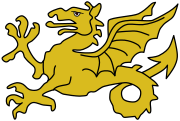House of Wessex
 Golden Wyvern of Wessex | |
| Country | Kingdom of Wessex, Kingdom of England |
|---|---|
| Titles | |
| Founder | Cerdic of Wessex |
| Final sovereign | Edward the Confessor |
| Founding | 519 |
| Dissolution | 1093 |
| Ethnicity | English (see details) |
The House of Wessex, also known as the House of Cerdic, refers to the family that ruled a kingdom in southwest England known as Wessex. This House was in power from the 6th century under Cerdic of Wessex to the unification of the Kingdoms of England.
The House, at this point, became rulers of all England (Bretwalda) from Alfred the Great in 871 to Edmund Ironside in 1016. This period of the British monarchy is known as the Saxon period, though their rule was often contested, notably by the Danelaw and later by the Danish king Sweyn Forkbeard who claimed the throne from 1013 to 1014, during the reign of Æthelred the Unready. Sweyn and his successors ruled until 1042. After Harthacanute, there was a brief Saxon Restoration between 1042 and 1066 under Edward the Confessor and Harold Godwinson, who was a member of the House of Godwin. After the Battle of Hastings, a decisive point in British history, William of Normandy became king of England. Anglo-Saxon attempts to restore native rule in the person of Edgar the Ætheling, a grandson of Edmund Ironside who had originally been passed over in favour of Harold, were unsuccessful and William's descendants secured their rule. Edgar's niece Matilda of Scotland later married William's son Henry I, forming a link between the two dynasties.
Timeline of Wessex and England rulers

See also
References
- Stephen Friar and John Ferguson (1993), Basic Heraldry, W. W. Norton & Company, ISBN 978-0-393-03463-9
- Naismith, Rory (2011). "The Origins of the Line of Egbert, King of the West Saxons, 802–839". English Historical Review 76 (518): 1–16. doi:10.1093/ehr/ceq377.
Retrieved from : http://en.wikipedia.org/wiki/House_of_Wessex